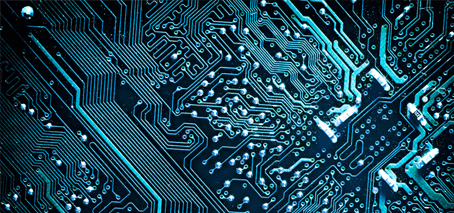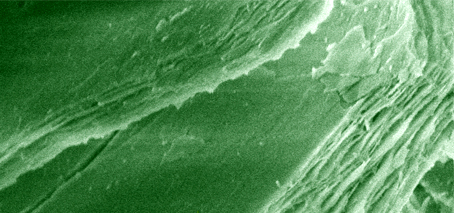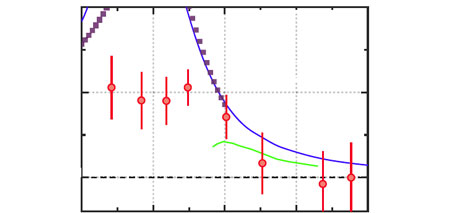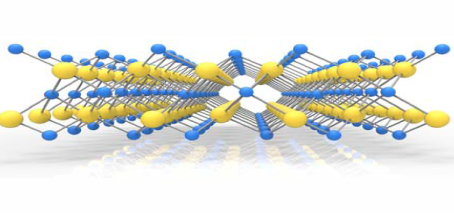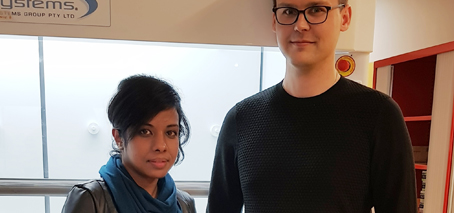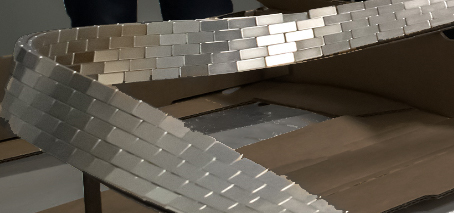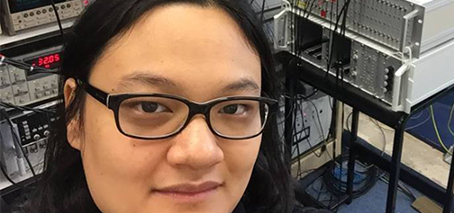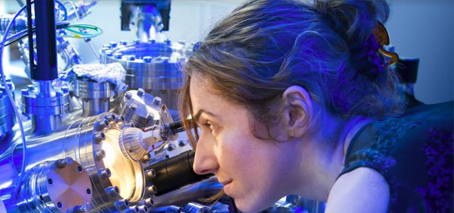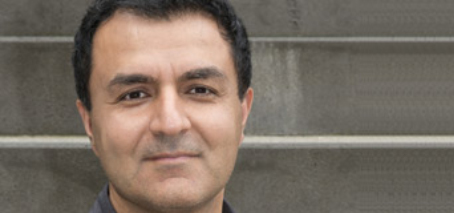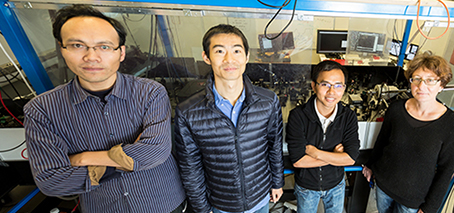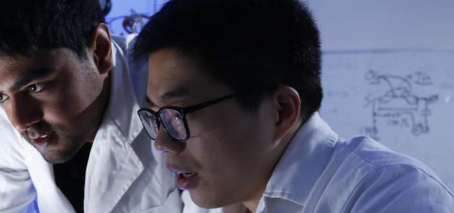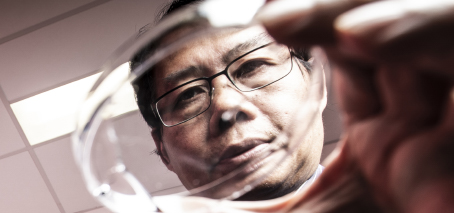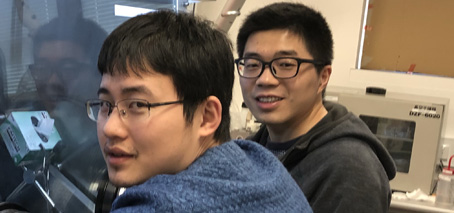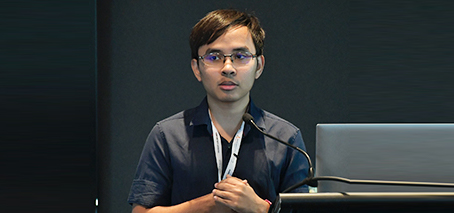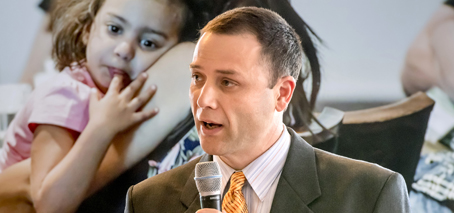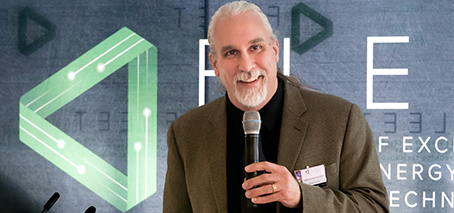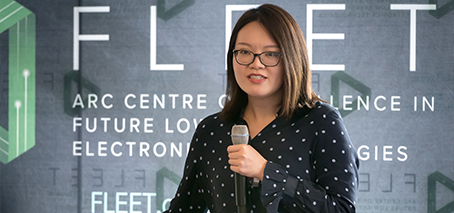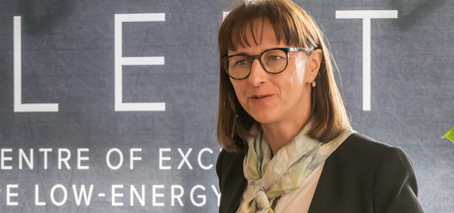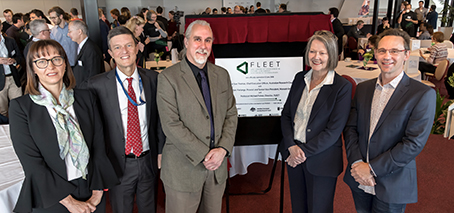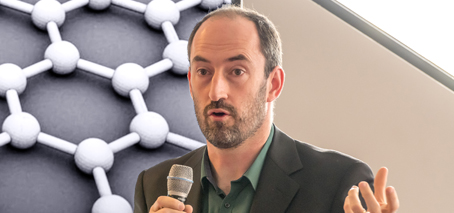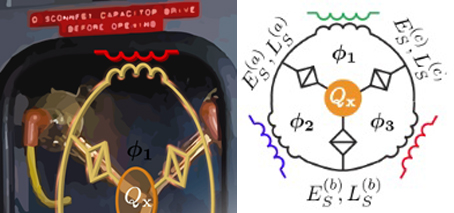First year physics students enthusiastic to explore ‘new’ physics Measuring quantum Hall effect with liquid helium-3, a Cold War side-product Window to topological materials and future electronics UNSW first year physics students have been measuring the quantum Hall effect (QHE), a relatively new piece of physics recognised by the 1985 Nobel Prize in Physics, which requires precision experimental setup. When …
FLEET collaboration aims to prevent energy losing its way
Published in Monash Lens 27 Sep 2018 Featuring Meera Parish & Michael Fuhrer, School of Physics & Astronomy, Monash University Cheaper, faster, smarter, smaller – the ever-evolving digital world has changed the way we live, as predicted by the law Gordon Moore outlined in 1965. Moore’s Law foretold that the number of transistors in a dense integrated circuit would double …
Polaritons and the thrill of fundamental discoveries: meet FLEET’s Eliezer Estrecho
FLEET’s Eli Estrecho recently finished his PhD, and is now a postdoctoral researcher, working with Professor Elena Ostrovskaya in the Polariton-BEC Research Group, Australian National University. We asked Eli some questions about his research, how he got into physics, and the thrill of fundamental discoveries. Q: Tell me about your research at ANU EE: I study hybrid particles of light …
Quick and not-so-dirty: a rapid nano-filter for clean water
FLEET researchers have designed a rapid nano-filter that can clean dirty water over 100 times faster than current technology. Simple to make and simple to scale up, the technology harnesses naturally occurring nano-structures of aluminium hydroxide that grow on liquid metal gallium. The researchers behind the innovation at RMIT University and UNSW have shown it can filter both heavy metals …
Quantum anomaly – breaking a classical symmetry with ultracold atoms
Scaling symmetry in a 2D Fermi gas breaks down with strong interactions between particles Quantum gas studies unlock fundamental physics—with an immediate application A FLEET study of ultracold atomic gases – a billionth the temperature of outer space – unlocks new, fundamental quantum effects. The researchers at Swinburne University of Technology studied collective oscillations in ultracold atomic gases – identifying …
Ferroelectric switching in Indium(III) selenide: potential for ultra-low energy electronics
The discovery of new ferroelectric properties in the novel, layered material Indium(III) selenide (β’-In2Se3) enhances this material’s candidacy for non-volatile memory and low-power electronic and optoelectronic switches. FLEET researchers at Monash University and UNSW were on the Australian-Chinese team that confirmed in-plane ferroelectricity in the material, β’-phase In2Se3. In2Se3 belongs to a class of layered materials known as van der Waals …
Pushing ‘print’ on large-scale piezoelectric materials
First ever large-scale 2D surface deposition of piezoelectric material Simple, inexpensive technique opens new fields for piezo-sensors & energy harvesting Researchers have developed a revolutionary method to ‘print’ large-scale sheets of two dimensional piezoelectric material, opening new opportunities for piezo-sensors and energy harvesting. Importantly, the inexpensive process allows the integration of piezoelectric components directly onto silicon chips. Until now, no …
Supercool, superconducting Mobius track helps communicate FLEET science
A super-cooled, superconducting Mobius-track impresses the crowds, helps embed FLEET science As a cool science demo, FLEET’s superconductor Mobius track ticks all the boxes: liquid nitrogen – tick. Superconductor – tick. Cool shape – tick. Relevance to the science – tick tick tick. The track features 1500 neodymium magnets, fixed into the shape of a Mobius strip, so that a …
New FLEET partnerships with Beijing and Wroclaw
We are extremely pleased to announce two new FLEET partners. The Beijing Computational Science Research Center (CSRC) and Wroclaw University of Science and Technology have joined the 13 other leading Australian and international science organisations partnering with FLEET. Wroclaw University of Science and Technology (WUST) is Poland’s top-ranked new-technology university, excelling in computer science, electronics and materials science. Our new Partner …
Putting a New Spin to the Hole Story
Controlling hole spin for future quantum spin-based devices, topological materials The ‘spins’ of electrons (and holes) in semiconductors have potential applications in spintronics, spin-based quantum computing, and topological systems. A particle’s spin is its intrinsic angular momentum. In a magnetic field, the spins of electrons or holes becomes oriented either parallel (‘spin-up’) or anti-parallel (‘spin-down’) to the field direction – just …
Building artificial atoms using holes
Hole-based artificial atoms could be key to spin-based qubit First isolation of one individual hole in a silicon MOSFET quantum dot A UNSW study published this week resolves key challenges in creation of hole-based artificial atoms, with excellent potential for more-stable, faster, more scalable quantum computing. Artificial atoms in quantum computing The spin states of electrons confined to semiconductor quantum …
Congratulations Harley Scammell: PhD recognised
Exciting new states of quantum matter enlisted to important environmental challenges FLEET’s Harley Scammell’s outstanding PhD recognised by UNSW The thesis “Interplay of quantum and statistical fluctuations in critical quantum matter” will be published by Springer in hardcover and ebook. “It’s really great to have this research recognised by UNSW”, says Harley. “Hopefully, having the thesis published at Springer will make this …
Atomic-scale material engineering, inspired by nature
New materials inspired by nature could be key to future electronics Self-assembled nanostructures have atomically-precise structure and tailored electronic properties Bio organisms are the most-complex machines we know, and are capable of achieving demanding functions with great efficiency. A common theme in these bio-machines is that everything important happens at the level of single molecules – that is, at the …
Congratulations Kourosh Kalantar-Zadeh, ARC Laureate Fellow
Congratulations to FLEET’s Kourosh Kalantar-Zadeh — named an Australian Research Council Laureate Fellow today. Kourosh’s significant influences in engineering include two-dimensional (2D) transition metal compounds, liquid metals, microfluidics, sensors, electronic devices and medical systems. He is an expert in chemical and biochemical sensors, nanotechnology, microsystems, materials science, electronics, gastroenterology, medical devices and microfluidics, and has made internationally-recognised contributions to the …
Chiral flow: twisting exciton-polariton condensates at exceptional points
Outstanding problem in exciton-polariton physics resolved using exceptional points at ANU Chirality of mode at EP opens future research avenues for exciton-polariton physics Researchers at ANU recently proved a novel method for generating orbital angular momentum states (vortices), with a topological charge that is ensured by an exceptional point. Recent studies at the ANU resolve an outstanding problem in exciton-polariton …
Why 2D? Measuring thickness-dependent electronic properties
Why 2D? What is it about two-dimensional materials that makes them so interesting for FLEET? FLEET UNSW/Wollongong collaboration finds transition point from 3D to 2D properties Constraining the movement of charge carriers (electrons or holes) to two dimensions unlocks unusual quantum properties, resulting in useful electronic properties. Although we refer to the layers within such materials as ‘2D’, they are …
Puzzling results explained: a multiband approach to Coulomb drag and indirect excitons
Taking a multiband approach explains ‘electron-hole reverse drag’ and exciton formation Mystifying experimental results obtained independently by two research groups in the USA seemed to show coupled holes and electrons moving in the opposite direction to theory. Now, a new theoretical study has explained the previously mysterious result, by showing that this apparently contradictory phenomenon is associated with the bandgap …
Science fiction becomes science fact as researchers create liquid metal heartbeat
Discovery has potential applications in artificial muscles, soft robotics and microfluidic circuitry In a breakthrough discovery, University of Wollongong (UOW) researchers have created a “heartbeat” effect in liquid metal, causing the metal to pulse rhythmically in a manner similar to a beating heart. Their findings are published in the 11 July issue of Physical Review Letters, the world’s premier journal …
Love of maths leads to spin PhD: Congratulations Dr Elizabeth Marcellina
Maths and spin: key to new electronics A love of maths brought Elizabeth Marcellina to the study of quantum and condensed-matter physics, where her recently completed PhD research studied possible routes to faster, more efficient electronics, by harnessing the ‘spin’ of the carriers in common semiconductors. As Moore’s law is coming to an end, much effort has been devoted to …
Centre collaboration combines material expertise
FLEET RMIT—UNSW collaboration measuring transport properties of van der Waals heterostructures FLEET PhD Cheng Tan (RMIT) visited UNSW’s labs in May to perform magnetic coupling measurements on 2D ferromagnetic crystals. The visit was reciprocated this month with FLEET Research Fellow Feixiang Xiang (UNSW) visiting RMIT to construct van der Waals structures for studying of 2D topological systems. This collaboration between …
Trapping light–matter particles at ANU
FLEET collaboration traps light–matter particles FLEET’s Research theme 2 seeks to create near-zero resistance flow of exciton polaritons, which are hybrid quasi-particles that are part matter and part light. Their ability to flow without resistance relies on formation of an exciton-polariton condensate – a collective quantum state that behaves as a superfluid. In superfluids, particles flow without encountering any resistance …
More than just great science: Matt Davis at the Centre Launch
FLEET will deliver much more than excellent science for Australian society. We are training some of the next generation of scientists, engineers, and entrepreneurs. We will help them develop not only technical research skills, but also transferable skills that will be useful to them no matter what their eventual career direction. For example, we have ensured that our research groups …
FLEET’s challenge and legacy
The challenge of finding a sustainable path to continuing the IT revolution is critical, and time is running out. I can tell you today with reasonable certainty that Moore’s Law will be declared dead within the seven-year operation of the Centre–perhaps even before our mid-term review! Computer chips will cease to gain in efficiency, and yet our demand for computation …
The case for FLEET: 8% of global electricity now consumed by computing
The information technology revolution has improved our lives, and we want it to continue. For example, our smartphone has become one of the most important devices of our everyday life: we use it to access up-to-date weather predictions, to plot the best route through traffic, and to watch the new series of House of Cards. And we expect it be …
Launching low energy electronics: FLEET Launch 12 June
Our insatiable appetite for computing means ITC already consumes 5–8% of global electricity, and is doubling each decade. Unless that ever-growing demand for computing can continue to be met with efficiency gains, the information revolution will slow down from power hunger. At the launch of a new Australian Research Council Centre of Excellence the audience heard that efficiency gains in current, …
Launch of FLEET Centre of Excellence to tackle hidden energy costs of computing
Official launch: Australian Research Council Centre of Excellence in Future Low-Energy Electronics Technologies 12 June 2018, 11 AM New Horizons Building, Monash University, Clayton We have an insatiable appetite for computing. But our ongoing need for computation is burning more than 5 percent of global electricity. And that figure is expected to double each decade. A new Australian Research Council …
The innovative science behind FLEET: Jared Cole at the Centre Launch
When using an electronic device to watch tv, listen to music, model the weather or any other task that requires information to be processes, there are millions and millions of binary calculations going on in the background. There are zeros and ones being flipped, added, multiplied and divided at incredible speeds. The fact that a microprocessor can perform these calculations …
Macro-chips and electronic card games: challenging students
Fresh minds develop hands-on learning methods for schools FLEET is developing innovative ways to communicate physics to school students. A collaboration with Monash University Science allowed the Centre to enlist fresh brains to this communications challenge. A team of maths and physics students from Monash Bachelor of Science–Global Challenges took on the task of developing hands-on games and resources to demonstrate …
Physicists invent flux capacitor, break time-reversal symmetry
In the popular movie franchise “Back to the Future”, an eccentric scientist creates a time machine that runs on a flux capacitor. Now a group of actual physicists from Australia and Switzerland have proposed a device which uses the quantum tunneling of magnetic flux around a capacitor, breaking time-reversal symmetry. The research, published this week in Physical Review Letters, proposes …
Agustin describes atomic-scale materials engineering on RRR
FLEET Chief Investigator Agustin Schiffrin spoke on science show Einstein a Go-Go about experimental physics at the atomic scale, and the study of exciting new nanomaterials with tailored electronic properties. Listen Agustin researches new nanomaterials with novel and exotic electronic properties, constructed of organic (carbon-based) molecules, sometimes inspired by bio-organisms. The team studies topological materials, which display a range of fascinating, …


